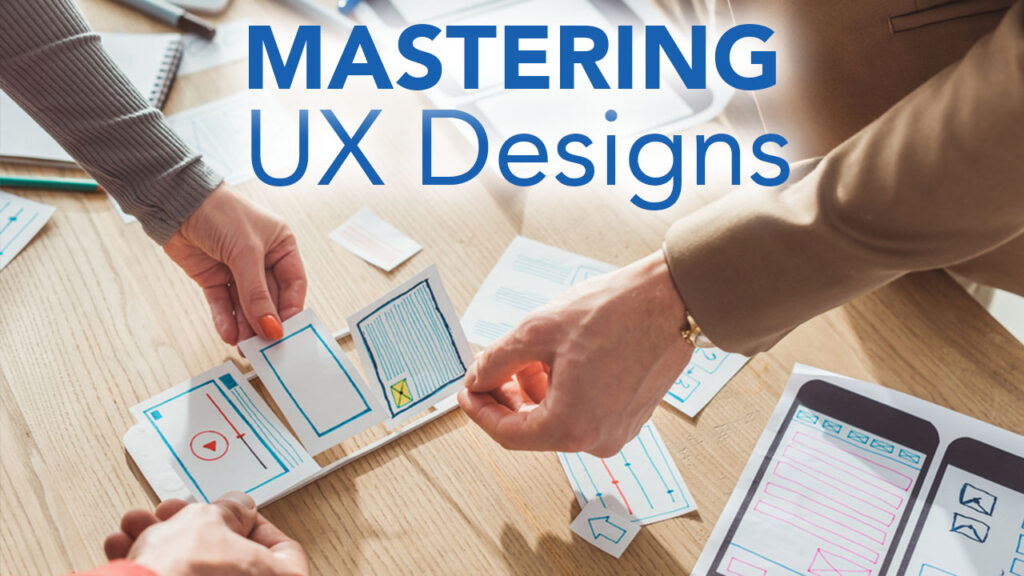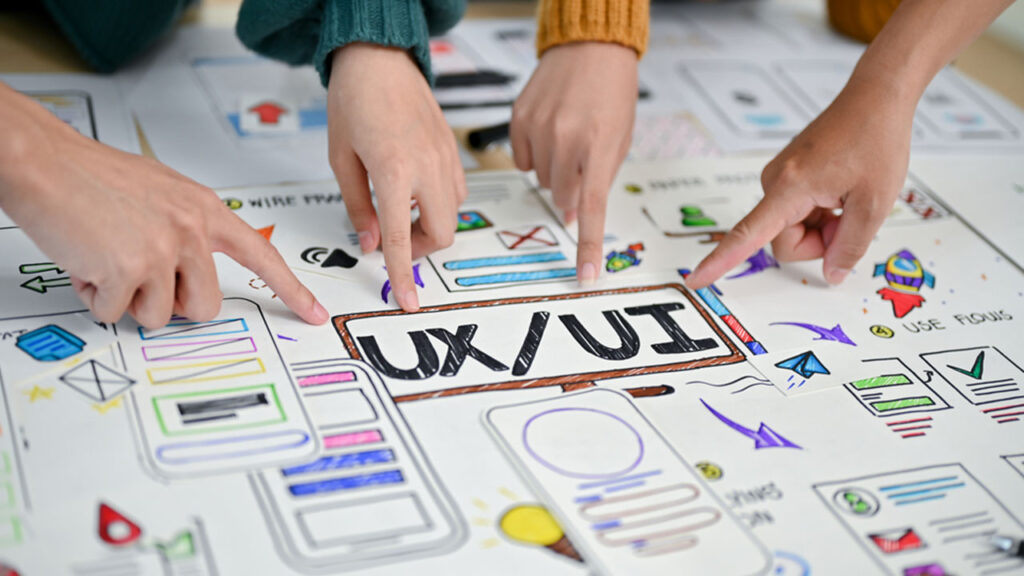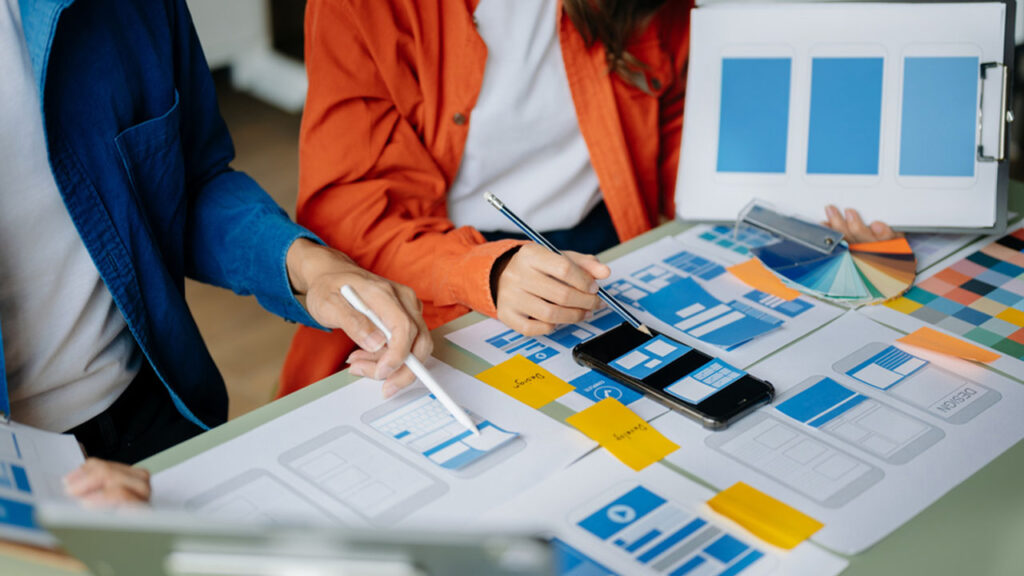UX Designs Demystified: Your Essential Guide to Mastering User Experience
Brett Lewis
Web Design - February 3, 2024

Interested in UX designs? You’re not alone. UX design is central to creating digital products that are not only functional but also a joy to use. This essential guide dives into the core of UX design, unraveling how it shapes user interaction and why it’s imperative for product success. From defining UX design and its goals to exploring the UX design process, we cover what you need to know to enhance user experiences effectively.
Key Takeaways
- UX design is pivotal to user satisfaction and business success, focusing on ease of use, problem-solving, and creating resonant experiences that go beyond aesthetics to improve loyalty, retention, and sales.
- The UX design process is a cyclical journey inclusive of user research, design and prototyping, and testing and evaluation, utilizing tools like Adobe XD, Axure RP, and Balsamiq for wireframing, prototyping, and seamless designer-developer collaboration.
- UX designers need a mix of technical skills, soft skills, and familiarity with industry tools, while successful career growth in UX design hinges on education, networking, mentorship, and a well-documented and transparent project portfolio.
The Essence of UX Design

UX design is like the invisible puppeteer behind a great performance. It shapes the way we interact with digital products, guiding us through the maze of modern technology. Far from merely creating visually appealing products, UX design is about creating experiences that resonate with users, aiming for ease and enjoyment. It is the unsung hero that drives business success, enhancing:
- customer loyalty
- retention
- conversion rates
- increased sales and revenue.
Beyond aesthetics, UX design plays the role of a problem-solver, uncovering and tackling specific user issues to devise solutions that meet user needs. It’s the meticulous planner that reduces development costs by identifying and fixing issues early in the design phase rather than post-launch. It’s the guardian that protects companies from high customer abandonment rates, ensuring a smooth and enjoyable user journey that keeps customers coming back for more.
Defining UX Design
But, what does UX design genuinely entail? The term “UX design” stands for “user experience design,” encompassing all aspects of a user’s interaction with a product, system, or service. It’s a process that aims to create products that are:
- Functional and reliable
- Enjoyable to use
- Intuitive
- Contribute to the overall satisfaction
At the center of UX design is the user’s journey. It’s not just about the destination, but also the scenery along the way. It’s the careful attention to details of usability and how each interaction with the product or service enhances the experience. It’s about creating a product that is not merely usable but delightful, not just functional but meaningful, not just reliable but memorable.
Fundamentally, the user, their needs, and their experiences form the crux of all these aspects.
The Goals of UX Design
Should UX design be a superhero, its mission would be to boost user satisfaction by making sure products are:
- practical
- user-friendly
- desirable
- easy to locate
- accessible
- credible
- valuable
It’s about applying strong problem-solving skills to identify and address user needs, creating meaningful and satisfactory experiences.
In the world of e-commerce, for instance, UX design might focus on optimizing checkout processes to reduce cart abandonment. It could also involve creating seamless user experiences within a mobile app, involving interaction, content, and sound design. The goal of UX design, ultimately, is to make everyday life more effortless for users by focusing on intuitive and thoughtful product design, aligning with users’ everyday tasks and objectives.
The UX Design Process

Visualize the UX design process as a cyclical journey, initiating with comprehending the users and culminating in a product that delivers a significant user experience. It’s a voyage that encompasses steps including:
- Consumer and competitor research
- Creating information architecture
- Developing wireframes and prototypes
- Performing testing and troubleshooting
- Conducting ongoing updates
It’s a process that champions the user, making them the hero of the story. It involves:
- Market research
- Wireframe development
- Prototype testing
- Collaboration with cross-functional teams to bring the design to fruition
The insights gained from user research are carefully analyzed and turned into actionable insights that drive design decisions and push projects forward. And nestled within this process is the Design Thinking Process, a method used for developing innovative solutions and meeting user needs.
User Research
User research acts as the guiding compass within the UX design process. It’s pivotal in understanding user needs and creating meaningful and seamless experiences. It’s the tool that cultivates empathy among designers, helping them understand user experiences and identify pressing issues.
In the hands of UX designers, methods such as interviews, surveys, questionnaires, and focus groups become powerful tools for conducting thorough user research. Tools like Google Forms for surveys and Miro for creating sitemaps become the instruments for gathering and analyzing data on product touchpoints. In essence, user research is the foundation upon which effective UX design is built.
Design and Prototyping

Upon establishing a solid foundation of user research, the design and prototyping process commences. This is where the blueprint of the user’s experience starts to take shape. Wireframes, which are low-fidelity designs that focus on structure, enable rapid modifications based on user feedback. These are then refined into high-fidelity wireframes that incorporate color schemes, typography, and interactions to provide a more comprehensive view of the final design.
The design is then turned into clickable prototypes that enable testing of information architecture, layout, and interactive elements prior to full development. These prototypes are crucial in facilitating clear communication between designers and developers, ensuring a shared understanding of interactive design elements.
Testing and Evaluation
The final phase of the UX design process is testing and evaluation. This is the stage where the design is put under the microscope, and every aspect is scrutinized. Usability testing is central to UX design, as it directly evaluates how users interact with a product and identifies areas for improvement.
Different usability testing methods cater to various stages of development and research goals, such as explorative, assessment, comparative, remote, and in-person testing. There are several tools and platforms available, such as UXCam, UserTesting, Applause, and Lyssna, that help UX designers conduct various types of usability tests.
The feedback obtained from these tests is then incorporated into the design process, refining design solutions and achieving a better user experience.
UX vs UI Design: Understanding the Differences

Now, let’s clarify two frequently misconstrued terms: UX and UI design. While they both play crucial roles in designing a product, they focus on different aspects. UX design is all about the overall user experience of a product, considering its look, feel, and usability. It’s the strategist that plans the user’s journey and ensures a smooth, enjoyable ride.
On the other hand, UI design specifically concentrates on the aesthetic and functional interface elements of digital products. It’s the artist that paints the interface with visually pleasing colors and shapes. Even though UX design can be applied to any product, service, or experience, UI design is particular to digital environments. It enhances the visual experience and interactivity, guiding users from one point to another within the interface.
It’s like the decor in a restaurant – it affects your overall experience, but it’s not the main reason you’re there.
UX Design Focus
Delving into UX design, it encompasses optimizing the experience, finding solutions, and enhancing overall functionality to fulfill user needs. It’s about making the complex seem simple, turning a daunting task into a pleasant experience.
For instance, effective mobile UX design is critical as it significantly affects app success, considering that the average app loses the majority of its daily active users within the initial days after installation.
Sharing prototypes with project stakeholders to gather feedback is a vital part of the UX design process that promotes collaboration and informs design decisions. Ultimately, UX design is about creating a product that is easy to use, enjoyable, and meets the user’s needs at every step of the journey.
UI Design Focus
Contrastingly, UI design is primarily concerned with the visual elements. It’s the process of designing interactive elements like buttons, sliders, and graphics which are central to the user engagement experience. It’s the careful application of color theory, selection of fonts, and creation of a consistent style across the product.
UI design is the icing on the cake, the beautiful wrapping paper on a present. It’s what makes a product not just functional but also beautiful. A skilled UI designer focuses on creating an intuitive interface that requires minimal effort from users to engage with, thereby enhancing product usability.
In essence, user interface design is the art of creating a visually pleasing and interactive UI design that enhances the user’s experience.
Essential Skills for UX Designers

To thrive in UX design, one requires a blend of diverse skills. These include technical skills, soft skills, and familiarity with industry tools. UX design is a multidisciplinary field that integrates knowledge from psychology, computer science, marketing, and customer service. Successful UX/UI designers must master various skills, including wireframing and prototyping, and apply them in the design process.
Technical Skills
Technical skills serve as the tools in the toolbox of a UX designer. Wireframing and prototyping are foundational technical skills in UX design, enabling designers to visualize and test the structure and functionality of digital products. Effective information architecture is critical for helping users navigate and understand digital products, and UX designers must be adept at organizing content logically.
Understanding user flow diagramming is another important skill. It’s like drawing a map that charts out each actionable step a user takes, enhancing the usability and coherence of digital interfaces. Familiarity with Agile UX design principles is also key, as it seamlessly integrates Agile development methodologies with user experience practices.
Soft Skills
Though technical skills constitute the spine of UX design, soft skills act as its heart and soul. They include:
- Empathy: allows UX designers to deeply understand the motivations, anxieties, and needs of users, which is fundamental for creating user-centric designs.
- Communication: enables designers to effectively convey their ideas and collaborate with team members and stakeholders.
- Critical thinking: helps designers analyze problems, evaluate different solutions, and make informed design decisions.
Possessing essential soft skills is crucial for successful UX design skills.
Communication is crucial for UX designers to effectively gather user data, collaborate with stakeholders, and present research findings and design ideas. Critical thinking and problem-solving skills are essential for identifying and addressing user pain points and creating solutions from multiple perspectives.
Industry Tools
Similar to a carpenter’s need for a reliable toolset, a UX designer must be acquainted with standard industry tools. Some common tools used by UX designers include:
- Adobe XD: used to create interactive, clickable prototypes rapidly
- Axure RP: used to create interactive prototypes with advanced functionality
- Balsamiq: used for quick wireframing with a hand-drawn feel
These tools help UX designers bring their ideas to life and create user-friendly experiences.
Collaboration is enhanced through tools like Figma, which supports layered interactions, and Adobe XD, which offers collaboration features and animated transitions. For mapping out detailed user flows and diagrams, designers use tools like Overflow, Lucidchart, and FlowMapp. And for designing UI elements, Sketch offers functionality for A/B testing and interacting with user journeys, while tools like Canva are used for visual design.
Types of UX Design Projects
The versatility of UX design is its extensive applicability across diverse projects and platforms. UX designers frequently work on projects involving e-commerce website redesigns or structuring user-friendly SaaS dashboards.
The versatility of UX design is evident through its presence in both conventional digital products and cutting-edge technologies.
Web and Mobile App Design
In the realm of web and mobile app design, UX designers play a crucial role in ensuring a smooth online experience for users. They work tirelessly to create intuitive and user-friendly interfaces that users find easy and enjoyable to use.
Whether it’s developing streamlined signup flows or analyzing actual user behavior with tools like UXCam Screen Flow, every aspect of the design is meticulously crafted to engage users and foster positive perceptions of mobile apps. Even when redesigning features for existing applications, UX design work is aimed at increasing usability and improving overall functionality.
E-commerce and Online Services
In the world of e-commerce and online services, UX design projects focus on:
- Streamlining the shopping experience by enhancing product pages and checkout processes
- Creating informative and user-centric dashboards that allow for efficient user account management
- Providing insightful data visualizations
UX design contributes to improving conversion rates by guiding users through a meticulously constructed sales funnel. It’s all about creating booking platforms that afford users uncomplicated search and filtering options, coupled with clear data presentation through user-friendly menus and catalogs. This is where ux designers work their magic, ensuring a seamless user experience.
Digital Marketing Campaigns
In the realm of digital marketing campaigns, UX design plays a pivotal role. Whether it’s designing:
- landing pages with a strong focus on UX to enhance conversion rates
- creating email templates
- social media content
- website chatbots to foster user engagement
Every aspect is meticulously planned and executed.
Effective UX design enhances digital marketing strategies by improving user engagement, brand awareness, and ultimately driving conversions and revenue growth. Project management in UX is key to ensuring digital marketing campaigns are smoothly executed, with all resources optimized for maximum impact and meeting deadlines.
Building a Career in UX Design
As UX design’s significance escalates, career opportunities in this field also expand. The field of digital design, which includes UX design, is expected to grow by 11% by 2029, indicating strong career prospects in this area.
It’s a well-compensated profession, with UX designers in the United States having a median pay of $97,460.
Education and Training
Budding UX designers can solidify their career foundation by taking related courses and building a portfolio through practical projects. There are several paths to gaining the necessary education and training in UX design. Traditional degree programs typically require two to four years of full-time study, while bootcamps offer immersive, hands-on training in design and prototyping and assist with building a professional portfolio.
For self-guided learners, online platforms offer a range of UX design resources, such as Google’s Foundations of UX Design course and the Interaction Design Foundation’s specialized offerings. Regardless of the educational path chosen, the goal is the same: to gain a deep understanding of user behavior, design principles, and the ability to create user-friendly products.
Networking and Mentorship
Networking forms another vital element in carving a successful UX design career. It uncovers opportunities like freelance gigs or full-time jobs that may not be widely advertised. Early career networking is crucial in the interconnected UX community where paths often cross. Attending industry events like conferences, service jams, and hackathons is an excellent strategy to grow a UX network.
Mentorship, on the other hand, offers a more personalized avenue for learning and growth. UX design mentors can offer:
- Seasoned career advice
- Practical help like preparing for job interviews
- Professional references, vouching for a mentee’s work quality and collaboration skills.
Creating a Portfolio
Creating a portfolio stands as one of the most pivotal steps in kick-starting a UX design career. It’s your personal showcase, a collection of your best work that demonstrates your talent and knowledge in the field. For designers with limited real-world experience, starting unsolicited redesigns or creating fictitious projects based on unsolved user problems can provide substantial material for a UX portfolio.
When presenting these projects, transparency is key; clearly stating the nature of these projects in the portfolio is essential to maintain credibility with potential employers. Documenting all steps of the design process, including research, development, and user testing, is essential for creating effective case studies in a UX portfolio.
Summary
UX design has evolved from a niche discipline to a crucial component of business success. It’s the invisible force that guides us through the digital world, making our encounters with technology not just functional but enjoyable. Whether you’re a business looking to improve your products or an aspiring designer eager to enter the field, understanding the essence, goals, and process of UX design is vital. As we’ve seen, UX design is not just about creating appealing interfaces; it’s about understanding users, solving their problems, and ultimately making their lives easier. And isn’t that a goal worth striving for?
Frequently Asked Questions
What does a UX design?
A UX designer is responsible for creating the look and feel of a product, website, or app, collaborating with various teams to ensure the final product meets user needs and expectations.
What are the 4 types of UX design?
The four types of UX design are Experience Strategy (ExS), User Research (UR), Information Architecture (IA), and Interaction Design (IxD). These specializations categorize the field into four main disciplines.
What are examples of UX design?
Some examples of UX design include B2C websites and applications.
What is difference between UI and UX?
The main difference between UI and UX is that UI design focuses on the visual and interactive elements of a product, like buttons and icons, while UX design encompasses the overall user experience with the product, including emotions and interactions.
What are some essential skills for UX designers?
Essential skills for UX designers include technical skills like wireframing and prototyping, soft skills like empathy and communication, as well as familiarity with industry tools. These skills are crucial for success in the field.
